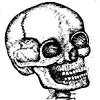13.5: Blood Typing
- Page ID
- 24203
Terms and Concepts
| Self antigen | A substance on red blood cells that marks the cells as “self”. Antigens are usually proteins or polysaccharides. |
| Foreign antigen | A substance that triggers an immune response by an organism because it is recognized as “non-self” or foreign. Foreign antigens can enter the body by inhalation (breathing), ingestion (eating), or injection (blood). |
| Antibodies | Produced by white blood cells (B lymphocytes) to react with foreign antigens and ultimately destroy them. |
| Antisera | Blood serum that contains antibodies to an antigen |
| Agglutination | A clumping reaction that occurs in blood when antibodies react to foreign blood cell antigens. |
| Transfusion | The process of giving blood from one individual to another. Only those with the same blood cell antigens are a match. |
Red blood cells contain cell surface antigens that mark the cell as “self”. These antigens are inherited from parent to offspring. Cells that are marked as self will not be targeted by the immune system. Cells that contain foreign antigens (not self) will be targeted by the immune system for destruction.
- If your blood cells exhibit the “A” antigen than you have type A blood.
- If your cells exhibit the “B” antigen then you have type B blood.
- People with type AB blood express both antigens
- Those with type O blood do not express either antigen. Type O blood is not recognized as foreign by anyone’s immune system because there are no antigens to detect on the red blood cells.
The Rh factor is a separate blood cell antigen. If your cells exhibit the Rh antigen, you are Rh positive (Rh+). Cells that lack the Rh antigen are Rh-. Rh- blood will not be recognized as foreign in an Rh+ person.
Fill in the table
Questions
- A and B are self markers known as _________________
- Antibodies are molecules produced by B lymphocytes (wbc) that attack ___________
- A person is blood type B-. Why can’t this person receive B+ blood?
- A universal donor is someone that can donate to people of all other blood types without fear of an antigen/ antibody reaction (agglutination). Which blood type is the universal donor (do not list the Rh factor)?
- A universal recipient is someone who can receive blood from a person with any blood type. Which blood type is the universal recipient (do not include the Rh factor)?
Blood Typing Simulation
No actual blood or blood products are used in the blood typing exercise. Scenario, you are a technician at busy city hospital. A patient is admitted who has been in a serious car accident and has suffered severe blood loss. You need to blood type your patient and 3 potential blood donors to see which donor has a blood type acceptable to be used for a transfusion. Need to practice? Play the “Blood Typing Game.”
https://www.nobelprize.org/educational/medicine/bloodtypinggame/gamev2/index.html
Procedure
- For each “individual” tested, you will need:
- A blood typing tray
- Bottles of Type A antisera, Type B antisera, and Rh antisera
- Clean toothpicks to mix the reactions
- Samples of “ blood”
- Add two drops of “blood” to each of the 3 wells on the tray
- Add two drops of the appropriate antisera and stir with a toothpick (use a fresh toothpick each time)
- Examine the tray to observe agglutination. Once you can ascertain the blood type of the individual, wash the tray. Fill in the table
- Rinse trays well and return to instructor
Which donor(s) have a blood type that can be safely transfused to the patient?


